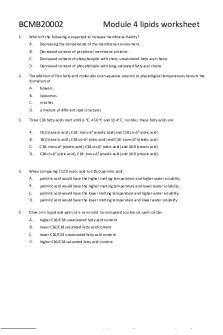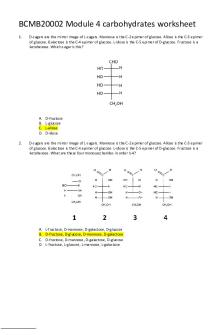Chem 162 Worksheet 4 with answers PDF

| Title | Chem 162 Worksheet 4 with answers |
|---|---|
| Course | General Chemistry II |
| Institution | University of Hawaii at Manoa |
| Pages | 5 |
| File Size | 264.6 KB |
| File Type | |
| Total Downloads | 75 |
| Total Views | 146 |
Summary
Worksheets...
Description
ANSWER KEY Chemistry 162 Worksheet 4
Name ________________
1) Which of the following represents the integrated rate law for a second-order reaction? Definition A)
= - kt B) = kt C) [A]t - [A]o = - kt D) k = Ae(-Ea/RT) 2) What data should be plotted to show that experimental concentration data fits a first-order reaction? What will the line look like? What is the slope equal to? Plot a sample graph below.
3) The half-life for the decay of radium is 1620 years. What is the rate constant for this first-order process?
t1 /2 =
0.693 k
(1620 yr )=
0.693 k
k =0.00042778
1 yr
4) Derive an expression for a "1/4-life" for a first-order reaction.
A) B) C) D) E) Start with integrated rate law for a first-order reaction: ln [A]t = − k t + ln [A]o Plug in “ t 1 / 4
A ¿0 for t and “ ¿ 1¿ ¿
for [A]t in order to solve for “1/4 life”:
A ¿0 ¿ A ¿0 1¿ ln ¿
Rearrange to solve for t1 / 4
A ¿0 ¿ ¿4 ¿ 1¿ ¿ −ln ¿
A ¿0 ¿ A ¿0 ¿ ¿ 4¿ ¿ ln ¿ ln (4)=k t1 /4 ln(4) ¿ t 1/ 4 k t1 / 4=
1.386 k
5) For a reaction, what generally happens if the temperature is increased? A) a decrease in k occurs, which results in a faster rate B) a decrease in k occurs, which results in a slower rate C) an increase in k occurs, which results in a faster rate D) an increase in k occurs, which results in a slower rate A generic rate law is as follows: Rate = k [A]M[B ]N If the rate increased without an increase in A or B, then the only explanation is that k must have increased. Additionally, the Arrhenius equation says that as temperature increases, k increases. 6) The isomerization reaction, CH3NC → CH3CN, is first order and the rate constant is equal to 0.46 s-1 at 600 K. What is the concentration of CH3NC after 0.20 minutes if the initial concentration is 0.30 M? A) 2.7× 10-1 M
B) 2.7× 10-3 M
C)1.2× 10-1 M
D) 1.2× 10-3 M
A ¿0 A ¿t =−kt +ln ¿ ln ¿ 1 A ¿t =−(0.46 )(12 s )+ ln (0.30 M ) s ln ¿ −3 A ¿t =1.2 x 10 M ¿
7) Given the following proposed mechanism, predict the rate law for the overall reaction. A2 + 2 B → 2 AB (Overall Reaction) Mechanism
A2 ⇌ 2A A + B → AB
fast slow
The rate law for the overall reaction is equal to the rate law for the slow step of the reaction mechanism. Overall Rate Law: Rate=k2[A][B] However, you cannot have intermediates or catalysts in the overall rate law. From the overall reaction, you can see that species “A” is an intermediate and needs to be replaced in the overall rate law. Having a fast step before a slow step creates a bottleneck with the first reaction, creating an equilibrium reaction. Therefore for the first reaction, the rate of the forward reaction is equal to the rate of the reverse reaction. k1[A2]=k-1[A]2 From this equation, we can solve for [A] and plug the result into the overall rate law: [A]=
√
k1 [A ] k −1 2
A [¿ ¿2][ B ] Overall Rate Law: Rate = k2 k1 √¿ k−1
√
8) Given the following balanced equation, determine the rate of reaction with respect to [O 2]. If the rate of formation of O2 is 7.78 x 10-1 M/s, what is the rate of the loss of O3? 2 O3(g) → 3 O2(g) B) 1.56 M/s
A) 0.519 M/s
Rate=
C) 2.34 M/s
D) 1.17 M/s
E) 7.78 M/s
−1 ∆ [O 3 ] 1 ∆ [O 2 ] = 3 ∆t 2 ∆t
M −1 ∆ [ O 3] 1 = (0.778 ) 2 ∆t 3 s ∆ [ O 3] ∆t
=0.519
M s
9) Determine the rate law and the value of k for the following reaction using the data provided.
Use the “Method of Initial Rates” to find the order with respect to each reactant. After we know the order with respect to each reactant, we can plug in experimental data from one experiment into the rate law to solve for k as well. By comparing Experiments 1 and 2, by inspection we see that when the concentration of ozone doubles and the concentration of nitrogen dioxide remains constant, the rate doubles. This means the order with respect to ozone is first order! To find the order with respect to nitrogen dioxide, use Experiments 2 and 3, where the concentration of nitrogen dioxide is changing and ozone concentration remains constant. Whenever it is difficult to see how the rate changes with concentration by inspection, you can always use math! Plug in experimental data for both experiments into the rate law, and then take the ratio of one rate law over the other (divide the two equations) and solve for the order with respect to the compound changing concentration. 1
0.66 M ¿ x 0.25 M ¿ ¿
(
Experiment 3 : 7.10
)
1 =k ¿ M∗s 1
0.66 M ¿ x 0.10 M ¿ ¿
(
Experiment 2 : 2.84
)
1 =k ¿ M∗s
Divide Exp 3 by Exp 2, simplify, and solve for x:
0.25 M x ¿ x=1 0.10 M 1 7.10 M∗s =¿ 1 2.84 M∗s The Rate Law is: Rate=k [ N O 2 ][ O 3 ] Know that we know the rate law, use data from any one experiment to find the value of k:
1 M∗s 0.25 M ¿1 ¿ 1 7.10 =k ¿ M ∗s
1 0.66 M ¿ k =43
(
)
10) The reaction of tris(1,10-phenanthroline)iron(II) in acid solution takes place according to the following chemical equation below. If the activation energy is 126 kJ/mol and the rate constant at 30°C is 9.8 × 10-3 min-1, what is the rate constant at 35°C?
Use Arrhenius Equation to find the rate constant for a reaction at a different temperature:
ln
9.8 x 1 0−3 ln
k2
1 min
(
k1 E A 1 1 − = k2 R T 2 T 1
)
J 1 1 mol − = 308.15 K 303.15 K J 8.314 K∗mol 126000
(
−2
k 2=2.2 x 1 0
1 min
)...
Similar Free PDFs

Protein Worksheet with Answers
- 4 Pages
Popular Institutions
- Tinajero National High School - Annex
- Politeknik Caltex Riau
- Yokohama City University
- SGT University
- University of Al-Qadisiyah
- Divine Word College of Vigan
- Techniek College Rotterdam
- Universidade de Santiago
- Universiti Teknologi MARA Cawangan Johor Kampus Pasir Gudang
- Poltekkes Kemenkes Yogyakarta
- Baguio City National High School
- Colegio san marcos
- preparatoria uno
- Centro de Bachillerato Tecnológico Industrial y de Servicios No. 107
- Dalian Maritime University
- Quang Trung Secondary School
- Colegio Tecnológico en Informática
- Corporación Regional de Educación Superior
- Grupo CEDVA
- Dar Al Uloom University
- Centro de Estudios Preuniversitarios de la Universidad Nacional de Ingeniería
- 上智大学
- Aakash International School, Nuna Majara
- San Felipe Neri Catholic School
- Kang Chiao International School - New Taipei City
- Misamis Occidental National High School
- Institución Educativa Escuela Normal Juan Ladrilleros
- Kolehiyo ng Pantukan
- Batanes State College
- Instituto Continental
- Sekolah Menengah Kejuruan Kesehatan Kaltara (Tarakan)
- Colegio de La Inmaculada Concepcion - Cebu














